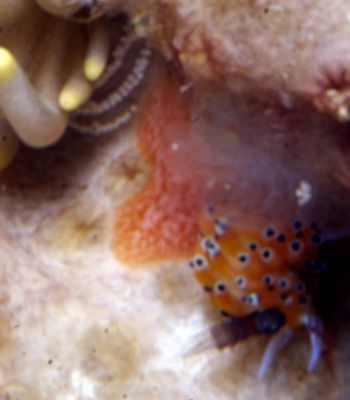Re: Phyllodesmium briareum eggs
May 27, 2001
From: Mary Jane Adams

Hi Bill,
Concerning your question about an egg photo, I only have one shot of the Phyllodesmium briareum with eggs. I enlarged the image and measured the eggs. They get quite fuzzy when magnified, but my best estimate is that the white rectangles are about
0.25 mm x 0.12 mm. However there appear to be some that are dumbbell shaped and there is a round one at the end. This leads me to think that two or more eggs are being laid in packets. If there are two eggs/packet then individual eggs would be about 0.12 mm in diameter. Does this make any sense? What is the size range for opisthobranch eggs?
It certainly was not smart choice for this slug to lay its eggs along side an egg eating slug. However, it looks to me like the translucent white stuff just above the Favorinus is another opisthobranch egg mass, so maybe it has already gorged itself and is about to leave. Anyway, we love them for their beauty, not their brains!
Best regards,
Mary Jane
divepng@yahoo.com
Adams, M.J., 2001 (May 27) Re: Phyllodesmium briareum eggs. [Message in] Sea Slug Forum. Australian Museum, Sydney. Available from http://www.seaslugforum.net/find/4429Thanks Mary Jane,
It certainly looks as though there could be a couple of eggs in some of the capsules. Usually there is only one egg per capsule in nudibranch egg masses but it is not unusual to find 2, 3 or 4 in some capsules. In some species with small eggs, multiple eggs per capsule is sometimes the norm.
Now to size. As a general rule each species has its own 'typical' egg diameter, though of course there is some intraspecific variation. The egg diameter can also give us an indication of the development type of the larvae - very small eggs almost certainly leading to planktotrophic veliger larvae which spend a long time feeding and growing in the plankton. At the other extreme very large eggs usually indicate that the larva is going to develop in the egg capsule, forgoing a free-swimming veliger larva stage, hatching out as a miniature crawling slug. Between these two extremes are eggs which develop into lecithotrophic larvae (free-swimming non-feeding larvae) which spend a very short time, sometimes only a few minutes, before settling to the bottom and metamorphosing into a crawling slug. There are exceptions to this rule as with any biological 'rule' but it gives us an indication which we can then set about proving or disproving for any species we are ineterested in.
As to egg size ranges, Tom Thompson produced a range of egg diameters based on nudibranchs of known development types.
• Planktotrophic: 40-170 microns
• Lecithotrophic: 110-250 microns
• Direct development: 205-400 microns
[1mm = 1000 microns]
There is considerable overlap between development types but your estimated diameter of 0.12mm (120 microns) suggests a veliger larval stage, and possibly one that is non-feeding. Certainly something worth following up.
Best wishes,
Bill Rudman
Related messages
-
Phyllodesmium briareum from the Philippines
From: Marcel Tanke, August 14, 2008 -
Phyllodesmium briareum? from Vietnam
From: Hua Thai Tuyen, March 6, 2008 -
Phyllodesmium briareum from Lembeh
From: Bruce Wight, February 17, 2007 -
Phyllodesmium briareum from Sulawesi
From: Mike Krampf, November 30, 2006 -
Re: Phyllodesmium briareum from Singapore
From: Toh Chay Hoon, November 27, 2006 -
Phyllodesmium briareum from Singapore
From: Toh Chay Hoon, May 27, 2006 -
Re: Phyllodesmium briareum in aquarium shipment
From: Michael Mrutzek, March 1, 2006 -
Phyllodesmium briareum in aquarium shipment
From: Michael Mrutzek, February 27, 2006 -
Phyllodesmium briareum from Malaysia
From: Ho Wei Kwok Alvin, October 8, 2005 -
Phyllodesmium briareum from Vanuatu
From: Vinka Stenhouse, March 10, 2003 -
Phyllodesmium briareum from Malaysia
From: Richard Houghton, July 14, 2002 -
Phyllodesmium briareum from Papua New Guinea
From: John Chuk, July 8, 2002 -
Phyllodesmium briareum from west Malaysia
From: Kheong Sann Chan, July 2, 2002 -
Phyllodesmium briareum from Malaysia
From: Kenneth Leong, June 30, 2002 -
Phyllodesmium from Pulau Aur, Malaysia
From: Barbara Phua, June 26, 2002 -
Phyllodesmium briareum egg laying
From: Mary Jane Adams , May 26, 2001 -
Re: Phyllodesmium briareum from SE Sulawesi
From: Lindsay Warren, February 21, 2000 -
Phyllodesmium briareum - direct development?
From: Lindsay Warren, February 18, 2000 -
Phyllodesmium briareum from Japan
From: Rie Nakano, November 29, 1999
